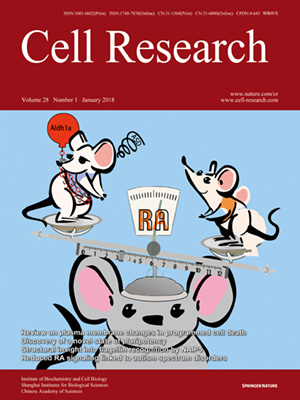
Volume 28, No 1, Jan 2018
ISSN: 1001-0602
EISSN: 1748-7838 2018
impact factor 17.848*
(Clarivate Analytics, 2019)
Volume 28 Issue 1, January 2018: 48-68
ORIGINAL ARTICLES
Excessive UBE3A dosage impairs retinoic acid signaling and synaptic plasticity in autism spectrum disorders
Xingxing Xu1,*, Chuanyin Li1,2,*, Xiaobo Gao1,2,*, Kun Xia3,*, Hui Guo3, Yali Li1, Zijian Hao1,2, Lei Zhang1, Daming Gao1, Chenfan Xu1, Huatai Xu4, Zhi-Qi Xiong4, Zilong Qiu4, Ling Mei5, Xiaoduo Xie1, Kangcheng Ruan1 and Ronggui Hu1
1Key Laboratory of Systems Biology, CAS Center for Excellence in Molecular Cell Science, Innovation Center for Cell Signaling Network, Shanghai Institute of Biochemistry and Cell Biology, Chinese Academy of Sciences, Shanghai 200031, China;
2University of Chinese Academy of Sciences, Shanghai 200031, China;
3The State Key Laboratory of Medical Genetics, School of Life Sciences, Central South University, Changsha, Hunan 410078, China;
4Institute of Neuroscience, State Key Laboratory of Neuroscience, CAS Center for Excellence in Brain Science and Intelligence Technology, Chinese Academy of Sciences, Shanghai 200031, China;
5Department of Medicine, Division of Gastroenterology and Hepatology, Medical College of Wisconsin, Milwaukee, WI 53226, USA
Correspondence: Ronggui Hu,(coryhu@sibcb.ac.cn)
The autism spectrum disorders (ASDs) are a collection of human neurological disorders with heterogeneous etiologies. Hyperactivity of E3 ubiquitin (Ub) ligase UBE3A, stemming from 15q11-q13 copy number variations, accounts for 1%-3% of ASD cases worldwide, but the underlying mechanisms remain incompletely characterized. Here we report that the functionality of ALDH1A2, the rate-limiting enzyme of retinoic acid (RA) synthesis, is negatively regulated by UBE3A in a ubiquitylation-dependent manner. Excessive UBE3A dosage was found to impair RA-mediated neuronal homeostatic synaptic plasticity. ASD-like symptoms were recapitulated in mice by overexpressing UBE3A in the prefrontal cortex or by administration of an ALDH1A antagonist, whereas RA supplements significantly alleviated excessive UBE3A dosage-induced ASD-like phenotypes. By identifying reduced RA signaling as an underlying mechanism in ASD phenotypes linked to UBE3A hyperactivities, our findings introduce a new vista of ASD etiology and facilitate a mode of therapeutic development against this increasingly prevalent disease.
10.1038/cr.2017.132
FULL TEXT | PDF
Browse 1653


